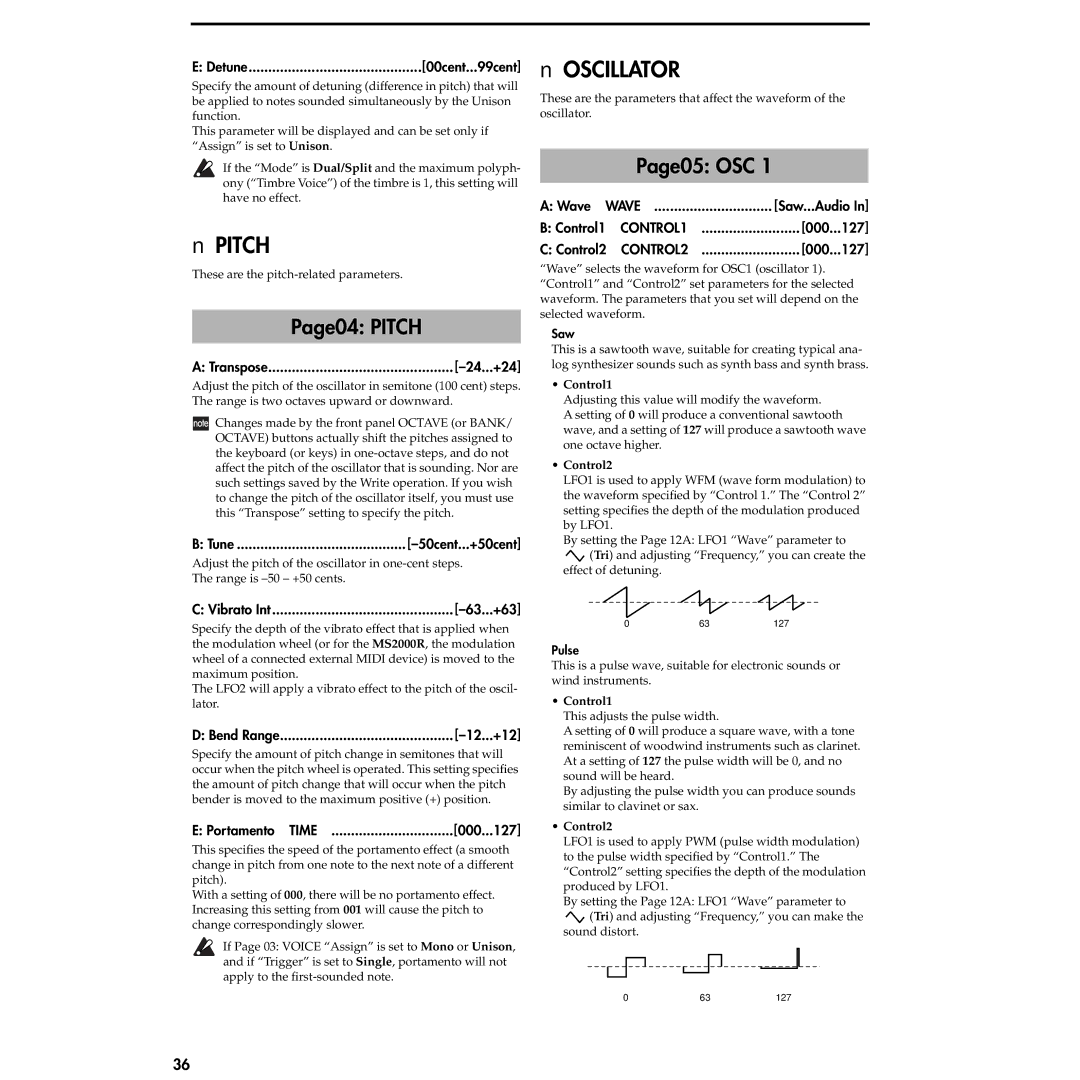
E: Detune | [00cent...99cent] |
Specify the amount of detuning (difference in pitch) that will be applied to notes sounded simultaneously by the Unison function.
This parameter will be displayed and can be set only if “Assign” is set to Unison.
If the “Mode” is Dual/Split and the maximum polyph- ony (“Timbre Voice”) of the timbre is 1, this setting will have no effect.
■PITCH
These are the
Page04: PITCH
A: Transpose |
|
Adjust the pitch of the oscillator in semitone (100 cent) steps. The range is two octaves upward or downward.
![]() Changes made by the front panel OCTAVE (or BANK/ OCTAVE) buttons actually shift the pitches assigned to the keyboard (or keys) in
Changes made by the front panel OCTAVE (or BANK/ OCTAVE) buttons actually shift the pitches assigned to the keyboard (or keys) in
B: Tune |
Adjust the pitch of the oscillator in
■OSCILLATOR
These are the parameters that affect the waveform of the oscillator.
Page05: OSC 1
A: Wave WAVE | [Saw...Audio In] | |
B: Control1 CONTROL1 | [000... | 127] |
C: Control2 CONTROL2 | [000... | 127] |
“Wave” selects the waveform for OSC1 (oscillator 1). “Control1” and “Control2” set parameters for the selected waveform. The parameters that you set will depend on the selected waveform.
Saw
This is a sawtooth wave, suitable for creating typical ana- log synthesizer sounds such as synth bass and synth brass.
•Control1
Adjusting this value will modify the waveform.
A setting of 0 will produce a conventional sawtooth wave, and a setting of 127 will produce a sawtooth wave one octave higher.
•Control2
LFO1 is used to apply WFM (wave form modulation) to the waveform specified by “Control 1.” The “Control 2” setting specifies the depth of the modulation produced by LFO1.
By setting the Page 12A: LFO1 “Wave” parameter to
![]() (Tri) and adjusting “Frequency,” you can create the effect of detuning.
(Tri) and adjusting “Frequency,” you can create the effect of detuning.
C: Vibrato Int |
|
Specify the depth of the vibrato effect that is applied when the modulation wheel (or for the MS2000R, the modulation wheel of a connected external MIDI device) is moved to the maximum position.
The LFO2 will apply a vibrato effect to the pitch of the oscil- lator.
D: Bend Range |
|
Specify the amount of pitch change in semitones that will occur when the pitch wheel is operated. This setting specifies the amount of pitch change that will occur when the pitch bender is moved to the maximum positive (+) position.
E: Portamento TIME | [000...127] |
This specifies the speed of the portamento effect (a smooth change in pitch from one note to the next note of a different pitch).
With a setting of 000, there will be no portamento effect. Increasing this setting from 001 will cause the pitch to change correspondingly slower.
If Page 03: VOICE “Assign” is set to Mono or Unison, and if “Trigger” is set to Single, portamento will not apply to the
0 | 63 | 127 |
Pulse
This is a pulse wave, suitable for electronic sounds or wind instruments.
•Control1
This adjusts the pulse width.
A setting of 0 will produce a square wave, with a tone reminiscent of woodwind instruments such as clarinet. At a setting of 127 the pulse width will be 0, and no sound will be heard.
By adjusting the pulse width you can produce sounds similar to clavinet or sax.
•Control2
LFO1 is used to apply PWM (pulse width modulation) to the pulse width specified by “Control1.” The “Control2” setting specifies the depth of the modulation produced by LFO1.
By setting the Page 12A: LFO1 “Wave” parameter to
![]() (Tri) and adjusting “Frequency,” you can make the sound distort.
(Tri) and adjusting “Frequency,” you can make the sound distort.
0 | 63 | 127 |
36
